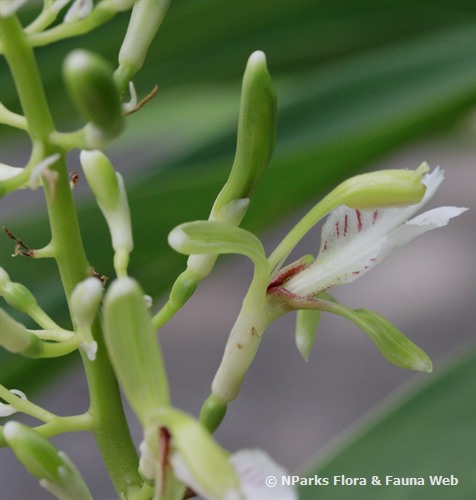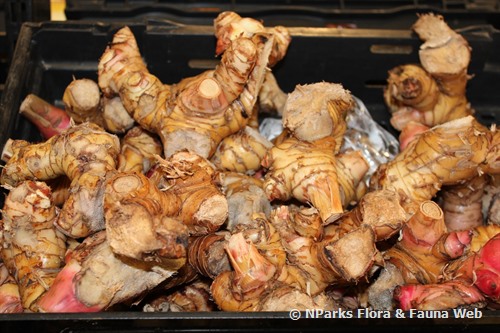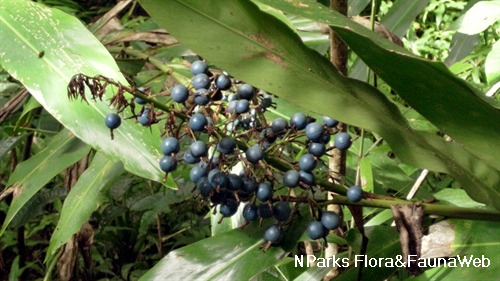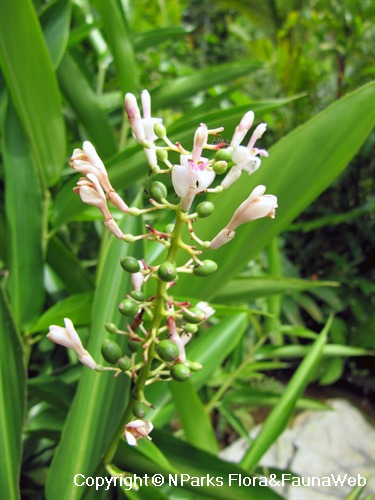
Back
Alpinia galanga
| Family Name: | Zingiberaceae |
| Synonyms: | Achasma galanga |
| Common Name: | Lengkuas, Galangal, Greater Galangal, Siamese Ginger, Lam Kew, 高良姜, 大高良姜, 红豆寇 |
Alpinia galanga, or Lengkuas, is a large herbaceous plant that can grow up to 3.5 m in height. Its rhizome is a versatile ingredient used in Southeast Asian cuisine such as in lontong, rendang and spice mixes, imparting a zesty heat and complimentary note to other ingredients in recipes. The Lengkuas also produce fragrant and edible yellow-white flowers that are eaten as vegetable.
Name
Classifications and Characteristics
| Plant Division | Angiosperms (Flowering Seed Plants) (Monocotyledon) |
|---|---|
| Plant Growth Form | Herbaceous Plant |
| Lifespan (in Singapore) | Perennial |
| Mode of Nutrition | Autotrophic |
| Maximum Height | 3.5 m |
Biogeography
| Native Distribution | S.E.A. |
|---|
Description and Ethnobotany
| Growth Form | Large herbaceous plant up to 3.5 m tall. |
|---|---|
| Foliage | The glossy, nearly hairless leaves are oblong to lance-shaped (50 cm long, 9 cm wide). |
| Stems | The rhizome, or underground horizontal stem, is light red or light yellow and highly branched (2-4 cm wide). |
| Flowers | Fragrant, yellow-white flowers (3-4 cm long) occur in large clusters on a spike-like or racemose inflorescence (10-30 cm long, 5-7 cm wide). |
| Fruit | The fruit is a round or ellipsoid capsule (1-1.5 cm wide) which contains 2-3 seeds. It is initially orange-red to dark red, and turns black at maturity. |
| Cultivation | It grows best outdoors in moist, but well-drained, fertile soil. Apply compost as a mulch to help keep the roots moist and cool. |
| Ethnobotanical Uses | Edible Plant Parts : Edible Leaves, Edible Stems, Edible Flowers Food (Herb or Spice): The rhizome has a sharp, spicy flavor which is popular in Southeast Asian cuisine. It is finely blended with other spices to make a paste for dishes like laksa an curries. (Fruit or Vegetable): The flowers are young shoots are steamed and consumed as a vegetable. Medicinal: In Peninsular Malaysia, the seeds are used in traditional medicine to treat vomiting, herpes, colic and diarrhoea. The Filipinos prepare a leaf decoction to treat rheumatism. In Java, the pounded rhizome is applied to wounds and sores. The rhizomes are used in the traditional treatment of skin diseases, respiratory diseases, to promote digestion and appetite (stomachic) after childbirth, for intestinal problems and as an expectorant and aphrodisiac. An infusion of the leaves is taken as a postpartum medicine. |
Plant Care and Propagation
| Light Preference | Full Sun, Semi-Shade |
|---|---|
| Water Preference | Moderate Water |
| Propagation Method | Division |
Foliar
| Mature Foliage Colour(s) | Green |
|---|---|
| Foliar Shape(s) | Non-Palm Foliage (Ovate, Oblong) |
| Foliar Margin | Entire - Wavy / Undulate |
| Leaf Area Index (LAI) for Green Plot Ratio | 3.5 (Shrub & Groundcover - Monocot) |
Non - Foliar and Storage
| Specialised Storage Organ(s) | Underground (Rhizome) |
|---|
Floral (Angiosperm)
| Flower Colour(s) | White |
|---|---|
| Flowering Habit | Polycarpic |
Image Repository
Others
| Master ID | 348 |
|---|---|
| Species ID | 1644 |
| Flora Disclaimer | The information in this website has been compiled from reliable sources, such as reference works on medicinal plants. It is not a substitute for medical advice or treatment and NParks does not purport to provide any medical advice. Readers should always consult his/her physician before using or consuming a plant for medicinal purposes. |







